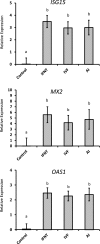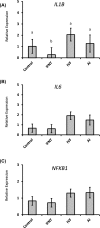Interferon tau-dependent and independent effects of the bovine conceptus on the endometrial transcriptome†
- PMID: 30203055
- PMCID: PMC6378860
- DOI: 10.1093/biolre/ioy199
Interferon tau-dependent and independent effects of the bovine conceptus on the endometrial transcriptome†
Abstract
This study investigated bovine conceptus-induced modifications to the endometrial transcriptome related to effects of interferon tau (IFNT), conceptus origin (in vivo vs. in vitro), and conceptus sex. In vitro (IVF) or in vivo (superovulation and artificial insemination, AI) produced blastocysts were transferred into recipient heifers on day 7 of the estrous cycle. On day 15, IVF- or AI-derived conceptuses were obtained by uterine flushing and individually placed on endometrial explants in media for 6 h. Explants were also cultured with media alone as a control or media containing 100 ng/mL IFNT. Total explant RNA was analyzed by RNA-Seq. Incubation of endometrium with IFNT or IVF- or AI-derived conceptuses changed (P ≤ 0.001) expression of 491, 498, and 576 transcripts, respectively, compared to the control. Further, 369 differentially expressed genes (DEGs) were common between explants exposed to IFNT or a conceptus. A total of 240 DEGs were uniquely altered by conceptuses (IVF- and AI-derived) but not IFNT. Of these transcripts, 46 were shared between the IVF and AI groups, while 61 and 133 were specific to IVF and AI conceptuses, respectively. Five genes [melanophilin (MLPH), prominin-2 (PROM2), myeloid associated differentiation marker (MYADM), vomeronasal 1 receptor 4 like (VN1R4L) and 5-hydroxytryptamine receptor 1A (HTR1A)] were more abundant in endometrium exposed to female compared to male conceptuses (P < 0.001). A single gene [ADP-ribosylation factor like GTPase 4C (ARL4C)] was more abundant in response to male conceptuses (P < 0.001) than female conceptuses. These data support the hypothesis that conceptus regulation of gene expression in the endometrium is complex and involves factors other than IFNT that may have a biological role in pregnancy establishment.
Keywords: RNAseq; conceptus; endometrium; explant; interferon tau; transcriptome.
© The Author(s) 2018. Published by Oxford University Press on behalf of Society for the Study of Reproduction.
Figures









References
-
- Hue I, Degrelle SA, Turenne N. Conceptus elongation in cattle: genes, models and questions. Anim Reprod Sci 2012; 134:19–28. - PubMed
-
- Geisert RD, Bazer FW. Regulation of implantation and establishment of pregnancy in mammals: tribute to 45 year anniversary of Roger V. Short's “Maternal recognition of pregnancy” Springer International Publishing, Switzerland AG: 2015.
-
- Wang J, Guillomot M, Hue I. Cellular organization of the trophoblastic epithelium in elongating conceptuses of ruminants. C R Biol 2009; 332:986–997. - PubMed
-
- Sandra O, Charpigny G, Galio L, Hue I. Preattachment embryos of domestic animals: Insights into development and paracrine secretions. Annu Rev Anim Biosci 2017; 5:205–228. - PubMed
Publication types
MeSH terms
Substances
Grants and funding
LinkOut - more resources
Full Text Sources
Other Literature Sources

